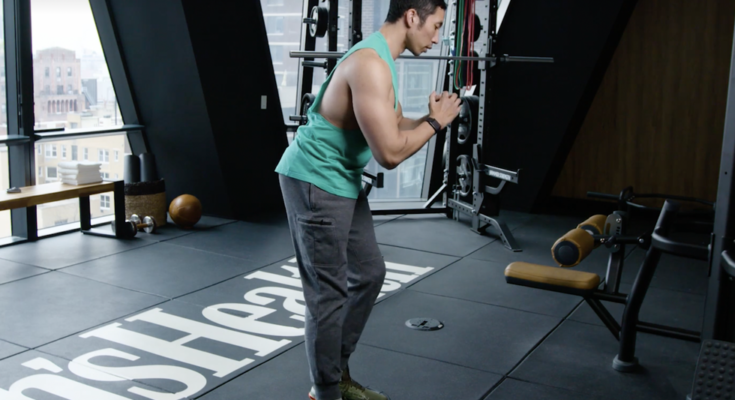SQUATS SHOULD MAKE you feel something, since they’re among the most important—and potentially the most heavily-loaded—compound lifts in your strength training arsenal. One thing you shouldn’t feel from squats is knee pain.
Knee pain will hinder your ability to properly execute and progress in the squat. That’s bad news for your training plan, since the squat is one of the great leg day staples. “Instead of our muscles being the limiting factor, our pain becomes the limiting factor,” says Ebenezer Samuel, C.S.C.S., Men’s Health fitness director.
Knee pain isn’t a death sentence for your leg day gains, however, or even your ability to perform squats. You don’t need to take a break from squatting to heal your aches. You just need to address the issue causing the knee pain in the first place. Here, Samuel looks at 4 common issues that typically lead to knee aching after squatting, and offers solutions to work through them.
Why You Have Knee Pain With Squats
Problem 1: You Load Your Hips Wrong
Yes, squats are a knee dominant exercise, but the hips are also heavily involved. To load some pressure into the glutes, you need to hinge backwards. If you don’t, extra stress can translate to the knees, which may cause pain. Poor hip loading can happen for several reasons, and you simply need to restore the feeling of proper loading and timing, Samuel says.
The Fix:
Touch Down Squat
The touch down squat allows you to keep a perpendicular shin at the knee throughout the movement, which is going force you to load at the hips. This exercise is going to help you “rebalance your entire squat motion,” Samuel says.
How to Do It:
- Grab one plate to start—if you get through a full set without knee pain, then you can go higher and grab another.
- Stand on your platform.
- Push your butt back to slowly lower your other leg to where your heel meets the floor. Go as slow as you can on the way down.
Set and Reps: Do 3 to 4 sets of 6 to 8 reps per side as a warmup to your standard squats
Problem 2: Your Glutes Are Weak
If you’re lacking glute strength, your hips won’t be able to externally rotate under great load they way they need to in a heavy squat. In a squat, your knees need to be able to track outward to properly align with your shins to create an efficient movement pattern. Opening up the knee requires strength through the glutes.
The Fix
Clamshells
These may look silly, but the clamshell is one of the best exercises to work on hip external rotation.
How to Do It:
- Lay down on your side, and place a resistance band just above your knee if you have one (you can still do the move against gravity if you don’t have one).
- Slightly bend your knee forward. Keep your heels together as you drive your top knee up.
Set and Reps: Do 2 to 3 sets of 20 reps per side as a warm up to your squats.
Monster Walks
This exercise also helps build outer glute strength, which will ultimately help your knee maintain proper position when squatting.
How to Do It:
- Place a resistance band just above your knees. You can also place one around your ankles for a little extra challenge.
- Bend your knees slightly to get into an athletic stance—think quarter squat—like a defender on a basketball court.
- Take 5 to 10 steps laterally each way. Think about stacking your knee over your ankle every step.
Set and Reps: Do 2 to 3 sets of 5 to 10 steps each direction as a warm up to your squats.
Problem 3: You Don’t Bend Your Knees Enough
Everyday movement doesn’t typically call for a ton of deep knee flexion, the bent position you’ll find yourself in when you perform a full-depth squat. Even if you’re only working on squatting to a 90 degree or parallel position, you still get a few benefits from working on deep knee bending. This action can help build tendon strength in the knee, and “spending time in deep knee flexion is going to train our quads in a lengthened position,” Samuel says.
The Fix
ATG Split Squat
The ass-to-grass split squat really emphasizes bringing your calf as close as you can to your hamstring, finding that intense strength into knee flexion.
How to Do It:
- Grab one or two plates to create a platform. Place one foot on the platform and extend out the back foot, finding a good split squat stance.
- Shift your weight down and forward onto the front leg. Drive your knee as far over and in front of your toes as possible—don’t be afraid to lift up off the heel a bit.
- Time your time, and feel that stretch. Hold for 2 to 3 seconds before pushing back up.
Set and Reps: Do 3 sets of 6 to 8 reps per side as an accessory motion on your leg days, or at least 2 to 3 times a week.
Assisted Squat with Heels Up
This move provides a similar idea to the split squat with a bilateral (two-foot) movement, while loading the knee just a little differently. You’re still trying to get the hamstrings to touch the calves.
How to Do It:
- Find something sturdy to hold on to like a post or side of a squat rack.
- Spread your feet out hip width apart, and load your weight into your toes. Lift the heels up off the ground.
- While holding your base, squat down to where you bring your calves as close to your hamstrings as possible, keeping your heels lifted the whole time.
- Hold that position for 2 to 3 seconds before pressing up.
Set and Reps: Do 2 to 3 sets of 5 reps, every day.
Problem 4: You Lack Ankle Mobility
A good squat depends more on ankle mobility than you would think. You have to shift the knees forward, and that can’t be done that without proper flexibility through the ankles—specifically in the Achilles tendon.
The Fix:
Kneeling Ankle Stretch
This is a very simple stretch that you can incorporate into your squat warm up routine to prep the ankles for motion.
How to Do It:
- Get down onto one knee. Place one thumb around your Achilles tendon on your front foot.
- Push down with that hand to ensure your heel doesn’t pop up off the ground while you shift your weight forward into that foot.
- Track your knee as far forward over your toes as possible.
- To get a deeper strength, place a little bit of pressure over top of your front knee.
Set and Reps: Do 1 to 2 sets of 3 to 5 reps during your squat warm up, or in between your squat sets.



